Val’s September walk now Tuesday 13th 8.30 am at Hollands Lane end of Downslink
Author: Val Bentley
A gorgeous morning for Andy, Linda, Mel, Maya and myself to walk round “Area 9” on the 21st – it took us 4 ½ hours to complete the circuit, and both Maya and I had a well-deserved nap after lunch! Started off by realising that I had forgotten notebook and pen, so Linda managed to find a pen in her car and I found a piece of paper in mine, so was able to note down species for the Wetland Bird count.
On the first part of the railway line we heard a few Dunnocks, and decided today’s aim was to get Linda to recognise their song. Work in progress on that as it is a fairly nondescript warble! A Goldcrest was singing above us by the crossroads with Sandy Lane, and when we reached the far side of the tunnel Mel spotted a Treecreeper in a tree on the embankment. A good place for them. Nuthatches and Stock Doves calling there too. In the fields towards Rye Farm were a pair of Canada Geese, Moorhens and Mallards, three Herons, a singing male Reed Bunting, and a Raven flew over “cronking”. It had something in its claws and perched in a distant tree pecking away at whatever it was.
We got to the point where Mike & his group had seen Little Ringed Plover and Water Pipit yesterday. The plover had moved on, but the Water Pipit was still there, and from views in the scope we decided it looked just like the one in my book, so a male in summer plumage with pink breast and grey head – as per https://www.rspb.org.uk/birds-and-wildlife/wildlife-guides/bird-a-z/water-pipit/ . Very nice. According to the RSPB info the species “breeds in the Alps and other mountain ranges of central and southern Europe”. About a dozen Lapwing were around here too, and in the pools 4 Teal and 18 Wigeon. Greylag Geese and a pair of Egyptian Geese were near the heronry, where 2 nests were occupied. Eight Cormorants in the oak tree there, and a Buzzard further south.
Along the river, a Green Sandpiper took off, then Mel spotted 2 waders fly low and away, from her description (as I missed them completely!) they must have been Dunlin. We had Skylarks and Linnets singing, Meadow Pipits calling, another Green Sandpiper at the overflow pit, a Stonechat on the brambles, another small group of Linnets, and a superbright group of over 20 Yellowhammers on Sharon Jesse’s land. A Kestrel was on top of a small tree and a Red Kite flew past, being harried by a crow. A couple of Tortoiseshell butterflies were on the wing along here too.
If you would like a printed copy of the 2020 Report put together by Paul and previously only available as a download, get in touch with Val at chetsford@talk21.com or 01273 494723. They cost just £3!
Postponed to Tuesday 22nd due to forecast of high winds again
The Henfield Birdwatch Report 2020 (1st edition)
Delighted to announce that Paul Cole’s enthusiasm for birds in Henfield has resulted in him producing a wonderful report of all that was recorded during 2020. Many thanks to Paul (and to his family for letting him spend the time to do it!) Enjoy!
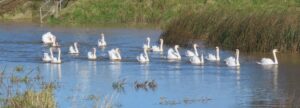
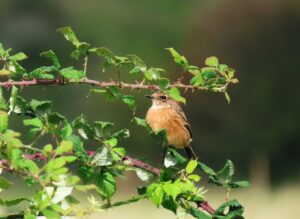
The end of May saw Henfield Birdwatch run another Big Bird Bash, in aid of The Haven, consisting of a series of walks throughout the parish to see how many different species of birds can be found in one weekend – albeit one which just spilled over into June! To maximize the chances of seeing as many as possible, one of the walks started at 6.30 am, and others didn’t leave until 6.30 in the evening.
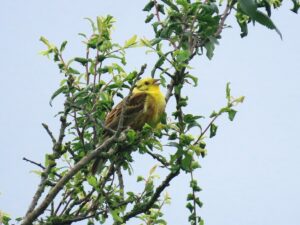 The early walk, led by Paul, started at the Downslink car park, and headed north. Fortunately not too many speeding bikes and noisy dogs around at that time of the morning, and the group was treated to some wonderful experiences. Two Nightingales were singing and flying around in the scrub bordering the track – maybe ones that established territory there last year, or possibly their offspring? By Betley Bridge a male Yellowhammer was singing that “littlebitofbreadandnocheeeese” song in a nearby bush, and a female was seen diving into another bush with nesting material, or possibly food, in her beak.
The early walk, led by Paul, started at the Downslink car park, and headed north. Fortunately not too many speeding bikes and noisy dogs around at that time of the morning, and the group was treated to some wonderful experiences. Two Nightingales were singing and flying around in the scrub bordering the track – maybe ones that established territory there last year, or possibly their offspring? By Betley Bridge a male Yellowhammer was singing that “littlebitofbreadandnocheeeese” song in a nearby bush, and a female was seen diving into another bush with nesting material, or possibly food, in her beak.

The 30 or so folk who joined Mike’s evening walks not only enjoyed the wonderful songs of up to five different Nightingales and caught a glimpse of the Kestrel family in their Woods Mill nest box, but also saw and heard a Turtle Dove, and spotted some Lapwing chicks – these are yet more species on the Red List, due to an alarming decline in numbers in recent years. Mike’s walks proved so popular he ended up running two more!
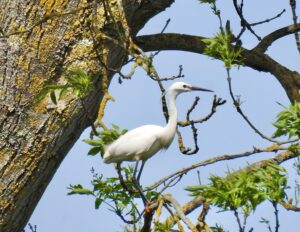
The final walk took in the area along the Downslink and the river to the south of the village. Grey Heron youngsters were still hanging around the couple of nests which had been occupied this year, and several Little Egrets were noticed, including one perched in a tree, showing off its main distinguishing feature – yellow feet! (Photo by Graham Speed)
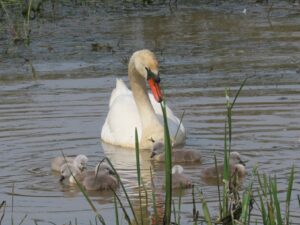
A pair of Mute Swans which were seen building a nest a couple of months ago, were proudly showing off their family of 6 cygnets. And some more Red-list birds put in an appearance, with several Skylarks heard singing, and chattering Linnets flying around by the river.
All in all an extremely successful Bash with lots of people joining the walks and recording birds in their gardens. Number of species seen was a superb 69. We asked for donations – which stood at £493 at the time of writing – all of which will go to our wonderful Henfield Haven.
Our new Henfield Birdwatch book now available from R & H Pets, Coopers Way for just a fiver. Or contact sightings@henfieldbirdwatch.co.uk.
The Book ….
…. is here at last! Members will receive a free copy. Otherwise, available at £5 from R & H Pets, Coopers Way, or email sightings@henfieldbirdwatch.co.uk
... it's here at last! Members will receive a free copy, otherwise, available from R & H Pets, Coopers Way, or email sightings@henfieldbirdwatch.co.uk
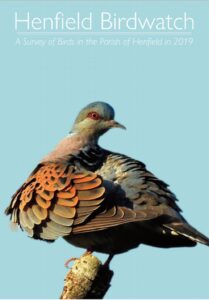
Read all about it! Or more specifically, read all about the birdlife in our lovely local surroundings. 2019 was our fifth five-yearly survey and it has taken getting on for a year to put all the reports together about what has been going on bird-wise in the parish.
We are delighted to announce that our new book is now hot off the press. To whet your appetite, in addition to accounts of all 115 species recorded during the year, these are some of the other goodies therein!
Review of the Year: Giving a flavour of the comings and goings of summer and winter migrants, such as the arrival of Swifts, Swallows, House Martins and Cuckoos in April, Nightingales in May, Redwings and Fieldfares in the autumn. Plus the more unusual visitors, a gorgeous pair of Garganey ducks in April, Whinchat, Wheatear and Wryneck in August, Yellow Wagtails in September, Black Redstarts in October & November, and a Water Pipit in December.
Garden Birdwatch: Members and non-members took part for a whole year and found 69 different species in their gardens, including Lesser Spotted Woodpeckers and Marsh Tits, both now pretty scarce species in Sussex.
Special Surveys: All three Henfield Commons were surveyed in 2019, and an ongoing survey of Perching Manor Farm is showing how numbers of farmland birds are benefiting from a farming system supporting wildlife. Our annual Nightingale Survey, started in 1999, reaches out to include Wineham and Edburton. Read how these magnificent songsters make the most of our local habitats.
In the Village: Hazel has been keeping an watchful eye on the House Martins which have found the Deer Park estate much to their liking – read her diary from the arrival of the first bird in April to their final departure in September. And Debbie’s enthusiasm for “our” Swifts shines through her account of their nesting activities, both in more natural sites in the eaves of houses, and in the specially provided nestboxes.
Photographs & Illustrations: The photos are amazing. They were all taken locally, and mostly by our members. Will Green’s illustrations are as wonderful as ever, and put the finishing touches to the book.
All members and garden birdwatchers will get a free copy of the book. They will be available to purchase at R & H Pet Supplies in Coopers Way, or contact Val Bentley on 01273 494723 or sightings@henfieldbirdwatch.co.uk Copies are £5.